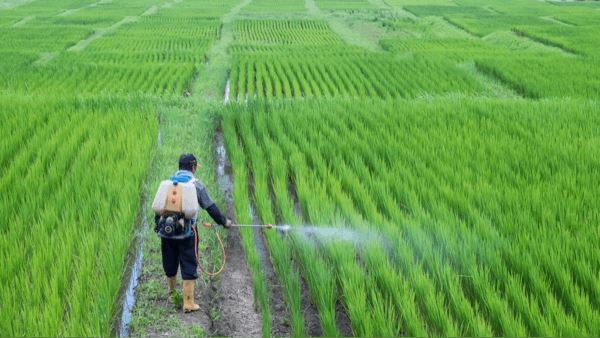
The registration of five active ingredients and ten new pesticide products have passed the technical review and the review of the National Pesticide Registration Review Committee in China and received approval for use. All ten products are biopesticides and were applied for by four enterprises including Sichuan Jinzhu Ecological Agricultural Technology Co., Ltd.
Annex 1 Registration Information of new pesticide products
|
Item |
Pesticide Registration Certificate No. |
Certificate holder |
Name of pesticide |
Dosage form |
Toxicity |
Active ingredient and content |
Pesticide type |
Crop/ site |
Target object |
|
1 |
PD20230099 |
Sichuan Jinzhu Ecological Agriculture Technology Co. LTD |
Lacerating poromycete GXMS1 |
Technical concentrate |
Micro toxicity |
Lacerating poromycete GXMS1, 150 billion CFU/ g |
bactericide |
|
|
|
2 |
PD20230095 |
Anhui Kewu Biological Technology Co. LTD |
Anagrapha falcifera nucleopolyhedrovirus Kew1 |
Technical concentrate |
Micro toxicity |
Anagrapha falcifera nucleopolyhedrovirus Kew1, 10 billion PIB/ ml |
insecticide |
|
|
|
3 |
PD20230103 |
Anhui Kewu Biological Technology Co. LTD |
Spodoptera frugiperda multiple nucleopolyhedrovirus Hub1 |
Technical concentrate |
Micro toxicity |
Spodoptera frugiperda multiple nucleopolyhedrovirus Hub1, 10 billion PIB/ ml |
insecticide |
|
|
|
4 |
PD20230094 |
Xi 'an Dingsheng Biological Chemical Co. LTD |
Trichoderma harzianum Rifaistrain 1-22 |
Technical concentrate |
Trichoderma harzianum Rifaistrain 1-22, 20 billion CFU/g |
bactericide |
|
|
|
|
5 |
PD20230101 |
Shaanxi Hengtian Biological Agriculture Co. LTD |
Bacillus amyloliquefaciens HT2003 |
Technical concentrate |
Micro toxicity |
Bacillus amyloliquefaciens HT2003, 100 billion CFU/ g |
bactericide |
|
|
|
6 |
PD20230098 |
Sichuan Jinzhu Ecological Agriculture Technology Co. LTD |
Lacerating poromycete GXMS1 |
Suspension concentrate |
Micro toxicity |
Lacerating poromycete GXMS1, 50 billion CFU/ g |
bactericide |
|
black shank |
|
7 |
PD20230093 |
Anhui Kewu Biological Technology Co. LTD |
Anagrapha falcifera nucleopolyhedrovirus Kew1 |
Suspension concentrate |
Micro toxicity |
Anagrapha falcifera nucleopolyhedrovirus Kew1, 2 billion PIB/ ml |
insecticide |
corn |
Ostrinia nubilalis |
|
8 |
PD20230100 |
Anhui Kewu Biological Technology Co. LTD |
Spodoptera frugiperda multiple nucleopolyhedrovirus Hub1 |
Suspension concentrate |
Micro toxicity |
Spodoptera frugiperda multiple nucleopolyhedrovirus Hub1, 2 billion PIB/ ml |
insecticide |
corn |
Spodoptera frugiperda |
|
9 |
PD20230092 |
Xi 'an Dingsheng Biological Chemical Co. LTD |
Trichoderma harzianum Rifaistrain 1-22 |
Wettable powder |
Trichoderma harzianum Rifaistrain 1-22, 600 million CFU/g |
bactericide |
tomato |
Botrytis cinerea |
|
|
10 |
PD20230096 |
Shaanxi Hengtian Biological Agriculture Co. LTD |
Bacillus amyloliquefaciens HT2003 |
Wettable powder |
Micro toxicity |
Bacillus amyloliquefaciens HT2003, 30 billion CFU/ g |
bactericide |
· |
bacterial wilt |
Product performance
1. Lacerating poromycete GXMS1
The antagonistic effect of Lacerating poromycete on pathogenic bacteria is caused by its secreted antibacterial metabolites. At the same time, its mycelium can invade the mycelium of the bacteria, distort, deform and vacuolize it, and finally completely invade and cover the pathogenic bacteria colony.
2. Anagrapha falcifera nucleopolyhedrovirus Kew1
After Anagrapha falcifera nucleopolyhedrovirus Kew1 is sprayed on corn crops and eaten by Ostrinia nubilalis, the virus multiplies in large numbers in the bodies of the insects, and finally infects and kills the insect pests.
3. Spodoptera frugiperda multiple nucleopolyhedrovirus Hub1
After Spodoptera frugiperda multiple nucleopolyhedrovirus Hub1 is sprayed on corn crops and eaten by Spodoptera frugiperda, the virus multiplies in large numbers in the bodies of the insects, and finally infects and kills the insect pests.
4. Trichoderma harzianum Rifaistrain 1-22
This product is a microbial fungicide, which can be used to control the roots, leaves, and fruits from crop diseases. After use, the mycelium of Trichoderma harzianum Rifaistrain senses the lectin secreted by the host (pathogenic bacteria) and tends to grow towards the host. The lectin can combine with the galactose residue on the cell wall of Trichoderma harzianum. Trichoderma invades the host through this position, causing the pathogenic bacteria to disintegrate due to the reduction of cell swelling pressure.
5. Bacillus amyloliquefaciens HT2003
This product is a microbial fungicide, and its action mechanism is mainly antagonistic, competitive and induced resistance. By successfully colonizing the plant rhizosphere, body surface or body, Bacillus amyloliquefaciens competes with the pathogen for nutrition around the plant, secretes antibacterial substances to inhibit the growth of the pathogen, and induces the plant defense system to resist the invasion of the pathogen, so as to achieve effective rejection, inhibition, and control of the pathogen.
If you need any assistance or have any questions, please get in touch with us via service@hfoushi.com.
CIRS Group has prepared a free Guide on Pesticide Regulation and Registration in China to help companies and individuals who would like to sell their pesticides to the People’s Republic of China and register their pesticide products with ICAMA. The guide describes key definitions, main regulations, authorities, pesticide registration process, data requirements, and post-registration labeling requirements in China.
Find out more details by clicking the below link
Free Guide on Pesticide Regulation and Registration in China

